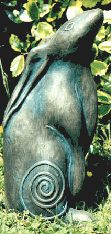 [In] the Great Lakes country and the upper Mississippi basin, we . . . encounter the trickster-hero typical of the West. For the Midwestern Siouans – the Winnebago, the Iowa, the Oto, the Omaha, the Ponca – this figure is Hare, called Mastshingke (rabbit) in the language of the Omaha. The Algonkian Ojibwa and Menominee call him Manabózho, or Nánabush, a variable name that has been translated Great Hare.
[In] the Great Lakes country and the upper Mississippi basin, we . . . encounter the trickster-hero typical of the West. For the Midwestern Siouans – the Winnebago, the Iowa, the Oto, the Omaha, the Ponca – this figure is Hare, called Mastshingke (rabbit) in the language of the Omaha. The Algonkian Ojibwa and Menominee call him Manabózho, or Nánabush, a variable name that has been translated Great Hare.. . . In general, the Siouans de-emphasize the hero’s trickster aspect, relegating the coarser and more trivial to Ishjinki, who corresponds to the Inktomi of the Sioux proper. Food production results from ribald adventures of Ishjinki, whereas the Siouan Hare is a deliverer, if a lighthearted one, rescuing humanity from the cannibal bears, bodiless heads, giants, and swallowing monsters of the ancient time.
 Today this sacred lore, largely forgotten, is best preserved in the far north, especially among the Cree, where Hoodwinked Dancers, Eye Juggler, and similar animals tales are still told.
Today this sacred lore, largely forgotten, is best preserved in the far north, especially among the Cree, where Hoodwinked Dancers, Eye Juggler, and similar animals tales are still told.Although hunting is losing out to wage occupations, and many now rely on government welfare, the Cree still think of themselves as hunters, and it is said that telling stories about animals is part of the “old agreement.” If game animals know that the myths are not being kept up, they will leave.
– John Bierhorst
The Mythology of North America
William Morrow and Company, 1985
Pp. 213-214
The Mythology of North America
William Morrow and Company, 1985
Pp. 213-214
Image 1: “Nanabush” by Teiji Hayama.
Image 2: From Petroglyphs Provincial Park near Peterborough, Ontario.






























